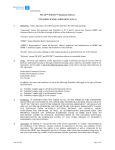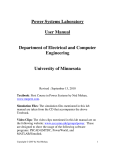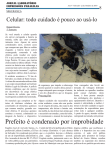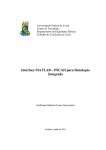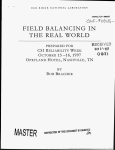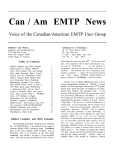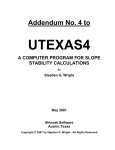Download E-TRAN - CiteSeer
Transcript
International Conference on Power Systems Transients – IPST 2003 in New Orleans, USA E-TRAN: Translation of Loadflow/Stability Data into Electromagnetic Transients Programs Garth Irwin1 and Dennis Woodford1 (1) Electranix Corporation, 107-865 Waverley Street, Winnipeg, Manitoba, R3T-5P4, Canada (e-mail: [email protected], [email protected]), (www: http://www.electranix.com ) Abstract – This paper outlines a new program called E-TRAN, which bridges the gap between loadflow/stability programs and electro-magnetic transients programs. It is essentially a translation program for power systems, but includes many features to avoid manual calculations (such as the automated formation of multi-port network equivalents, initialization of machines/sources in large systems, auto-routing to generate graphical views of the network, data sanity checks …). II. TRANSLATION OF LOADFLOW DATA INTO AN EMT PROGRAM Most loadflow program use (or can export to) the PSS/E .raw data input format. This format includes data for busses, branches, generators, loads, switched shunt devices, dc links etc… Many loadflow database files are quite large (>50,000 busses) which makes the case prohibitively large to run entirely in EMT programs. In this case, the user can identify a portion of the network to translate in detail, and the translation program will automatically create a network equivalent for the remainder of the network (for details see Section III below). The user can identify the portion of the network to translate in detail using 5 methods: • Keep all busses • Keep all busses in an Area. • Keep all busses in a Zone. • Keep a central bus and “N” busses away. This option includes a voltage level (ie keep all busses 230 kV and above) and 3 busses away from my central bus). • Keep listed busses. The program currently supports the PSS/E* .raw loadflow input format and is also partially capable of translating ATP/EMTP data files into PSCAD**/EMTDC*** V3 or V4. Keywords – E-TRAN, loadflow, transient stability, electromagnetic transients, network equivalents, PSCAD/EMTDC. I. INTRODUCTION Most utilities use loadflow and transient stability programs to study the fundamental frequency behaviour and interactions in power systems. They often maintain large databases of their network data suitable for such studies. Power systems are becoming more complex and EMT (Electromagnetic Transient) programs are being used more frequently for large system studies, particularly when detailed modeling of control systems and non-linear devices are required. EMT programs can be used for studies involving complex interactions in systems with multiple generators, motors, wind farms, HVDC links, FACTS devices etc… which often cannot be adequately studied by transient stability analysis. Many utilities have the data available for their entire system in loadflow program format, and great effort is required to re-enter the network data for use in EMT programs. The authors of this paper face this problem frequently when they help clients perform studies. They developed the E-TRAN program in order to bridge the gap between loadflow/stability programs and EMT programs. The translation program performs the following functions: • Translates PSS/E .raw input files into PSCAD/EMTDC V3 or V4 (either entire cases or portions of a case). • Auto-generates multi-port network equivalents. • Auto-routes non-graphical bus/branch/load connection data into graphical components in PSCAD. • Initializes large systems with multiple machines/source/generators. * ** Figure 1 shows the Graphical User Interface (GUI) dialog which is used to determine which portion of a large network is to be translated in detail. PSS/E is a registered trademark of Power Technologies Inc. PSCAD is a registered trademark of Manitoba HVDC Research Centre. EMTDC is a registered trademark of Manitoba Hydro. *** Figure 1: Bus Selection GUI Dialog 1 International Conference on Power Systems Transients – IPST 2003 in New Orleans, USA • Transmission Lines (both PI sections and Bergeron traveling wave models). • Transformers and Phase Shifters (including the extraction of modified leakage reactances from impedance correction tables). • Loads (Constant PQ, Current, Impedance and RLC) • Switched Shunt Devices • Zero Impedance Branches • DC Links (multi-terminal links not yet supported). Each model in the library accepts the same data format as is used in the PSS/E .raw file (ie PU impedances (RXB) on 100 MVA base, L-L Voltages etc). Each model can be used with single phase circuits, three phase circuits (with 3 phase connections) or three phase SLD circuits (a single electrical array connection instead of 3 phase connections). This runtime library is freely available. The translation program runs on any MS-Windows platform. It consists of a GUI (Graphical User Interface) using a “Wizard Style”, which means the user completes a form and then clicks on “Next” to proceed to the next set of options. Once all input and output files have been identified and all options set, the GUI launches the solution engine. The solution engine is contained in a separate DLL (Dynamic Link Library) so it can be imbedded in other userwritten programs. E-TRAN V1 supports the following input formats: • Full support for PSS/E versions 23-26 (.raw and .seq files) [2] • Partial support for EMTP/ATP data files The following output formats are supported: • PSCAD V3 .psc file (single phase circuits only) [3] • PSCAD V4 .psc file (three phase circuits using SLD (Single Line Diagram) drawing. [3] Substitution of Detailed Device Data EMT studies often require more detailed device data, including non-linearities (transformer saturation, surge arresters, power electronic devices and harmonic sources…) and other specialized data not required by loadflow programs (such as transformer winding and core geometries…). E-TRAN includes support for a Substitution Library, in which a user can maintain detailed model data for a given device. The program uses the bus from and to numbers and the circuit identifier to uniquely identify an element to be substituted. After translating a circuit, it first consults the Substitution Library to see if more detailed data exists for each device, and if so, it will write out the detailed data instead of the basic RXB model. For example, a user can maintain a Substitution Library containing detailed core/winding geometries and saturation data in transformers (data not available in the .raw input files). Users can also maintain frequency dependent transmission line data containing conductor geometry and frequency dependent model parameters etc… The detailed data will be automatically used in new cases instead of the basic RXB data available in loadflow files. The Substitution Library can also contain custom-written as well as any circuit contained in multi-level page components. For example, a detailed DC link or SVC model can be maintained in the library, complete with multi-level subpages with exact control models. If the Substitution Library contains a machine, E-TRAN will replace the required initial condition information in the machine based on the loadflow solution, thus ensuring a bumpless initialization of the electrical and mechanical machine dynamics. Additional data formats and versions are being worked on. In addition to the translated output file, a .log file is generated which contains details of the conversion process, error/warning messages and network equivalent details. Graphical Auto-Routing The PSS/E .raw input file does not contain graphical coordinate information (although a .draw file may be available for portions of the network), so translation of data into PSCAD (which is graphically based) requires auto-routing to determine the positions and coordinates of all devices. The translation program performs the auto-routing using formal Graph Theory mathematical algorithms. The basic concept is to select a starting node and to draw in one line all series branches which connect to new nodes (this is called a “trunk”). Next all “feedback” branches (other series branches connected between nodes in the same “trunk”) and all branches to ground are drawn. A new “trunk” is drawn (working in reverse from existing nodes) and the procedure is followed recursively until all nodes and branches in a given page have been drawn. The resulting drawings are guaranteed to be drawn correctly, regardless of the complexity of the interconnections. If the circuit to be drawn in PSCAD will not fit on a page, the program will use the voltage levels to separate the drawings onto sub-pages and sub-sub-pages etc… If a single voltage level will not fit on the page, it will still create sub-pages (and sub-sub-pages etc) based on geometrical positioning of the busses. Entire circuits of more than 50,000 busses have been drawn and translated in their entirety. The resulting output file can be directly loaded in PSCAD V3 (as a single phase circuit) or in PSCAD V4 as a three phase SLD (Single Line Diagram). III. GENERATION OF MULTI-PORT NETWORK EQUIVALENTS When the input loadflow circuit is too large to run in an EMT simulation program, the translation program can automatically create a multi-port network equivalent. The network equivalent is derived by a network reduction of the fundamental frequency admittance matrix (Y) of the entire network. The following procedure is followed: E-TRAN Runtime Library for PSCAD A library of components for PSCAD has been written which contains all devices required in the loadflow data file: 2 International Conference on Power Systems Transients – IPST 2003 in New Orleans, USA source terms on the diagonals of the network equivalent are modified to provide an equivalent solution. • The admittance matrix of the entire system (Yfull) is generated in Per Unit (let there be N busses in the original loadflow file) • Busses to be “kept” (ie translated in detail) are identified (let there be K busses to be kept) and Yfull is re-ordered so as to move the kept busses to the bottom of the Yfull matrix. • A partial LDU decomposition is performed (using sparse methods) to collapse Yfull from an NxN matrix to a KxK matrix (called Yreduced). • The admittance matrix of all branches and devices entirely contained in the K kept busses is created (let this be Ykept – also a KxK matrix). • The admittance matrix of the network equivalent (called Yeq) is the difference between the reduced Y matrix (Yreduced) and the kept Y matrix (Ykept), ie Yeq = Yreduced – Ykept • The elements of Yeq are realized as a circuit with RLC elements and mutually coupled elements. The off-diagonal entries are represented by either a PI section or a transformer (if the bus voltages at each end of the branch are different), and the diagonal entries are represented with a voltage source to ground. • The voltage source magnitude and phase of the diagonal elements in the network equivalent are automatically calculated to give the correct loadflow in the kept network. The resulting multi-port network equivalent will give the correct loadflow solution under normal operating conditions, but will also give the correct faulted and open-circuit solutions. Single port network equivalents are commonly used, and although they generate the correct steady state loadflow solutions, they will not provide the correct faulted or open circuit solutions (as they do not represent the offdiagonal entries of the Yeq matrix). The translation program includes an optional off-diagonal Ylimit parameter, which can be used to ignore extremely weak off-diagonal connections (this may be useful in real-time applications where sparsity in the network equivalent is desirable). If the off-diagonal Ylimit parameter is set very large, then multiple single port equivalents will be generated (without off-diagonal elements). Note that the network equivalent will not be of size KxK. It will contain elements only where portions of the network are not fully contained in the kept network. The above calculations are complicated by the presence of ideal branches (ie 0 resistance/inductance series elements) and phase shifters. The ideal branches are correctly handled in the program matrix calculations, and it is ensured that ideal branches are entirely contained in either the network equivalent or in the kept network (they cannot span from one to the other – if they do, a bus is added to the kept network). Phase shifters are generally represented by a non-symmetrical admittance matrix, which is not suitable for representation by a passive network equivalent sequence circuit. The phase shifters (that are part of the network to be equivalenced) in the program are represented with symmetrical admittance elements, and the voltage IV. MATCHING THE LOADFLOW SOLUTION USING EMT PROGRAMS Loadflow programs solve the steady state fundamental frequency equations of a large power system using an iterative algorithm. The result is the magnitude and phase of all bus voltages, as well as the PQ flow through all network branches. The iterative process will continue until the sum of PQ flows at any bus (called the PQ mismatch) are smaller then the convergence criteria (say 0.001 pu). The heart of the solution is the complex system admittance matrix (Y). V(w) * Y(w) = i(w), where Y(w)=1.0/(R+jwL) EMT programs solve the differential equations of the power system[1], such as: V(t) = R*i(t) + L*di/dt The EMT solution algorithm does not require iterations, but is a direct matrix solution. The accuracy of the solution depends on the frequency of interest and the selected time step (often 50 uSec). At fundamental frequency, the solution integration error is generally negligible since there are many samples over a fundamental frequency period, so the EMT steady state solution should theoretically match very closely to the loadflow solution. Circuits translated by E-TRAN have been observed to match the loadflow to a very high degree of accuracy, whether it is a very large system (1,000’s of busses) or a small system run with a network equivalent. The use of the multi-port network equivalent ensures the steady state, short circuit and open-circuit conditions will be satisfied (not possible with simple equivalent sources placed at boundary busses). One potential problem occurs when a very small impedance is used in the original loadflow case (say an inductor of 0.001 pu). In order for power to flow through this branch, a very small phase shift is required: P= V1 * V 2 * sin(δ 1 − δ 2 ) Xl The problem is that the PSS/E .raw format [2] outputs the bus phase angles (δi) to a limited number of decimal points, so it is possible that the bus angles across a low impedance branch (read from the data file) are identical (so no power flows) yet the internal loadflow solution will show power flowing. This will show up as opposing power mis-matches at the busses at each end of the branch, but will not affect the remainder of the solution. This problem is solved (for non-transformer branches) using the zero impedance branch feature in PSS/E (ie make R=0.0 and the L less than or equal to 0.0001), which will make the branch impedance 0.0, and effectively collapse the two busses together into a single bus. The same zero impedance branch logic and collapsing methods are followed in the translation program (allowing any number of 3 International Conference on Power Systems Transients – IPST 2003 in New Orleans, USA whose magnitude and phase angle are determined by the loadflow program (this bypasses long time constants in the electrical and mechanical components of the machine). • Run the network up to steady state. FACTS devices, HVDC Links etc… will easily startup during this period since the AC network short circuit ratio is artificially high (ie the system impedance is lower). • Initialize the electrical circuitry in the machine model and switch to a machine model which is running with its internal rotor angle fixed (ie mechanical dynamics are still bypassed). • Initialize all mechanical and external control functions (such as the torque/governor, field voltage/exciter, multi-mass models etc…) and fully release all machine models. • The system is now fully initialized and ready for faults/disturbances. It is suggested that a Snapshot be taken (as used in PSCAD/EMTDC) so as to save these initial conditions in an external input file. This allows multiple runs and subsequent studies to be performed quickly without having to re-run the initialization process. The loadflow program calculates the steady state bus magnitude and angles, as well as the real and reactive power in all generator/machines. The translation program uses this information inside its calculations (and in the formation of network equivalents) and generates the EMT simulation files (a .psc file for PSCAD/EMTDC). By default it generates the circuit with simple voltage sources for each machine, but if a machine is in the Substitution Library, it will directly set the initial conditions in the machine model (or any model) as per the procedure outlined. One minor flaw with this initialization (or any method which relies on positive sequence loadflow results) is that a small oscillation may arise at the point of initialization if the system has any negative sequence components of voltage or current. This can occur when there are unbalanced (non-ideally transposed) transmission lines or unbalanced loads. The negative sequence component in the system results in a small second harmonic on the field/torque of the machine, which will show up on the machine frequency (even in steady state). Thus the time at which the machine is released may introduce a small offset which cannot be avoided (this is generally a minor concern). It should be theoretically possible to perform a three phase loadflow using phase based quantities (instead of a positive sequence loadflow), transfer the positive and negative sequence initial conditions to the machine model, and initialize the mechanical/electrical machine equations including the negative sequence effects, but this has not been accomplished (nor is it critical to do so in the author’s opinion). series, parallel and loop connections of ideal branches) and transferred to the PSCAD/EMTDC models. Users should be aware of the type of measurements they are using to compare the EMT results to the loadflow results. EMT simulations can contain harmonic distortions, dc offsets (particularly near DC links or saturated transformers etc…) which can affect some measurement techniques (such as RMS). The program measurement components (in the Runtime Library) utilize a very fast recursive DFT algorithm which extracts the positive sequence, fundamental frequency quantities, so measurements made with using these components should match the loadflow results. Users should also be sure that the fundamental frequency behaviour of any device used in the Substitution Library (which the program will output to the case it translates instead of using the simple RXB translated model data – see Section II) should match that used in the loadflow. For example, if a user puts a detailed frequency dependent transmission line model in the Substitution Library, then the program will output this data instead of the simple RXB Bergeron traveling wave model. To ensure the loadflow matches 100%, the user should use the Line Constants output from the frequency dependent line model in the EMT program to obtain the positive sequence RXB values (which are for an incremental unit length), update/re-solve the loadflow file, and finally re-run the translation program. For very long transmission lines, correction factors should be applied before using the data in the loadflow program (the E-TRAN User’s Manual documents suitable long-line correction formula). V. INITIALIZATION OF LARGE MULTI-MACHINE SYSTEMS IN EMT PROGRAMS EMT simulations with multiple machines or sources must have the system properly initialized in order to avoid long run-up times associated with machine inertial swings, governor time constants etc… The critical parameters which must be initialized are the internal angles of all machines and sources, as well as the state variables of all control circuits which have long time constants (such as governors, exciters, stabilizers, multi-mass SSR (subsynchronous resonance) models etc…). It is not critical to fully initialize the state variables of the entire AC network, as it generally contains much smaller time constants and has sufficient damping so the system can be started from 0.0 conditions and ramped up to the steady state in a very short time. A complete initialization is possible for simple systems, but a generalized connection of devices with more complex systems with FACTS devices, power electronics, non-linear branches etc… makes this either too time consuming or un-reliable. A very reliable procedure (that works with large and complex systems) is as follows: • Start the EMT simulation with all voltages and currents at 0.0 conditions. • Model the machines initially as a simple ideal voltage source (or one with the series impedance as defined by ZR and ZX in the loadflow generator data), VI. EXAMPLE 1 – TRANSLATION OF A 18,000 BUS SYSTEM INTO A 15 BUS CIRCUIT NEAR A DC LINK (WITH A NETWORK EQUIVALENT) This example shows a very dense portion of a network near a bipolar HVDC converter station (see Figure 2). The 4 International Conference on Power Systems Transients – IPST 2003 in New Orleans, USA transmission lines and devices close to the area of study be represented with detailed frequency dependent and/or nonlinear device models. This substitution can be automated using the Substitution Library (see Section II). It often requires experience and judgment on the part of the user to determine how much of the system should be represented in detail, and at what point an equivalent can be inserted. VII. EXAMPLE 2 – TRANSLATION OF A 160 BUS SYSTEM REDUCED TO 15 BUSSES OF INTEREST (WITH A NETWORK EQUIVALENT) This example shows a portion of a small network at a 345 kV bus. The circuit is loaded in PSCAD V4 and was directly generated by the translation program from a PSS/E .raw input file. The program directly translated only 2 busses away from the main bus (which resulted in a 15 bus circuit – see Figure 4) and formed a network equivalent of the remaining circuit. The equivalent network (on a sub-page) uses transformer branches for the off-diagonal branches since the interface busses are at different voltage levels. In this case the entire circuit was only 160 busses, so it could have easily been translated and run in PSCAD without the need for any network equivalent. The example cases shown in this paper were derived from relatively small loadflow cases in order for demonstration purposes, but very large (up to 50,000 bus) loadflow cases have been translated successfully by the program. The only known limitation on the network size limit is determined by the computer memory available. VIII. CONCLUSIONS This paper describes a program which translates popular loadflow data (which does not contain graphical information) directly into an electromagnetic transients program. The process includes the formulation of multi-port network equivalents, the auto-routing of the circuit (so as to generate a graphical view of the network) and the ability to substitute detailed non-linear model data (suitable for EMT studies) instead of simple RXB type loadflow data. The resulting translated circuits in an EMT simulation are able to match the loadflow solution to a high degree of accuracy, whether the entire circuit or a portion of the network is translated and a network equivalent is used. Figure 2: Example 1 – A 15 Bus Circuit Generated by E-TRAN from 18,000 Bus Loadflow Case original circuit was more than 18,000 busses, but for this example, the program directly translated only 1 bus away (which resulted in a 15 bus circuit) from the HVDC bus and formed a network equivalent of the remaining circuit. Figure 3 shows the equivalent network (on a sub-page). The voltage magnitude and phase angle of the equivalent sources are automatically calculated to match the power flow of the solved loadflow. Note the multi-port equivalent is valid for steady state as well as for open/short circuit conditions. The isolated diagonal sources at the bottom of Figure 3 indicate isolated portions of the network which feed radially from busses in the kept network and are not connected to the bulk of the network equivalent. In any network equivalent, it would be wise to look at the diagonal or off-diagonal impedances in the network equivalent and to include more busses in the direct translation if the impedances are small (the small impedances generally indicate strong coupling from nearby transmission lines or generators). It is also recommended that the ACKNOWLEDGMENTS The authors wish to thank the Manitoba HVDC Research Centre Inc for their assistance in providing details of the PSCAD V3 and V4 graphical data formats. REFERENCES [1] H.W. Dommel, “Digital computer solution of electromagnetic transients in single- and multi-phase networks,” IEEE Trans., Power App. and Syst., Vol. PAS-88 (4), pp. 388-398, 1969. [2] PSS/E Program Operation Manual [3] PSCAD User’s Guide and EMTDC Theory Manual 5 International Conference on Power Systems Transients – IPST 2003 in New Orleans, USA Figure 3: Example 1 Network Equivalent Sub-Page Figure 4: Example 2 – A Small Network Concentrating on a 345 kV Bus 6







